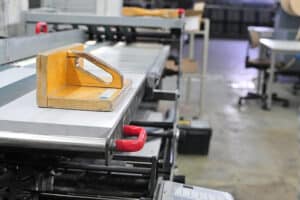WORKERS’ COMPENSATION FOR PRINTING & PUBLISHING INDUSTRIES
 The cost of workers’ compensation insurance for printers is normally slightly cheaper than the average cost of work comp coverage in general because both the frequency and severity of injury tends to be less than average. Insurance coverage for printers can be obtained from most work comp insurance carriers.
The cost of workers’ compensation insurance for printers is normally slightly cheaper than the average cost of work comp coverage in general because both the frequency and severity of injury tends to be less than average. Insurance coverage for printers can be obtained from most work comp insurance carriers.
Printers vary in the type of materials they produce from newspapers to magazines to books and pamphlets, but all printers have primarily the same physical hazards to contend with.
Some Of The Risks
Some of the risks employees of printers are exposed to include:
- Moving parts of machinery
- Inks and other chemicals
- Various types of manual labor
- Lifting of materials
Writers for newspapers are susceptible to carpal tunnel injuriesbecause they work on the computers all day.
- They are normally passionate about their occupations, so tend to work until they experience pain, which is the point when one might need more than simply night-time splinting to correctthe problem.
- Lower wage personnel that “insert” supplements into a newspaper, for example, may experience repetitive injuries as well.
The workforce of printers, outside of the management staff, is blue-collar workers.
- It is often a mixture of both long-term experienced employees and employees of short duration with the printing company.
- On-going safety training and safety programs for the workforce are common among the large scale printers but less so among the smaller operations.
Printing companies tend to be located in metropolitan areas making medical care readily available when needed.
- The selection of medical providers by the employer or employee will depend on the state statutes.
- Medical care costs will average slightly lower than the average cost for all industries.
- Bringing employees back on temporary transitional duty assignments can be challenging if the company has long-ago negotiated labor contracts with “minimum-manning” provisions.
The cost of both temporary total disability and permanent partial disability indemnity benefits averages slightly less than the overall average for indemnity benefits. Occupational injuries from repetitive motion occur at a higher rate than in most industries (such as from working on printing presses and other machinery.)
Some Categories Related To Printers
Some categories related to printers that would have the same or similar work comp issues include:
- Book binders
- Film Print shops
- Sign makers
- Sign painters
- Billboard companies
Transitional / Modified Duties in the Printing and Publishing Industries
Employees with work restrictions in Printing and Publishing are generally easily accommodated.
- Temporary transitional duty should be easily identified.
- Most employees should be accommodated through modification of their own job or by performing tasks of other jobs within their abilities as identified by the physician.
- Capital expenditures in injury-reducing equipment such as lift-tables can pay for themselves in this industry and make accommodation easier.
If there is an applicable union contract, be sure to review the terms to verify modified duty is not prohibited or restricted. Examples of temporary accommodation include:
Sample Transitional Duty Jobs in the Printing and Publishing Industries
| Press Operator: | Temporarily assign to a press that is “lighter” to operate. |
| Helper / Material Handler: | Modify tasks to fall in line with physician assigned abilities by making loads smaller before transporting or providing assistance with heavy lifting such as ink for the press. |
| All Plant Employees: | Assist in assembling boxes for shipping and loading smaller boxes to be shipped. |
| Light Janitorial: | Employees can use a broom and long handle dust pan to clean up spills and paper debris. |

